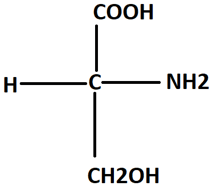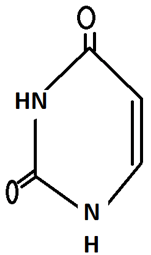This set of Class 11 Biology Chapter 9 Multiple Choice Questions & Answers (MCQs) focuses on “Biomolecules – Chemical Analysis – 2”.
1. Which amino acid has a methyl group as R?
a) Serine
b) Glycine
c) Valine
d) Alanine
View Answer
Explanation: Amino acids have a chiral carbon bound with an amino group, an acid group, a hydrogen and an R group. In alanine, the R group is a methyl group. In glycine, the R group is a hydrogen atom.
2. Which amino acid has a hydroxy methyl group as R?
a) Tryptophan
b) Lysine
c) Serine
d) Leucine
View Answer
Explanation: An amino acid having a chiral carbon, surrounded by an amino group, an acid group, a hydrogen atom and a hydroxymethyl group as the R group is serine. It is a polar amino acid due to its R group.
3. Which of these is an amino acid with pH less than 7?
a) Valine
b) Lysine
c) Glutamic acid
d) Histidine
View Answer
Explanation: a pH lesser than 7 signifies that the amino acid is acidic in nature. Glutamic acid has pH less than 7, hence it is an acidic amino acid. Histidine and lysine are basic while valine is a neutral amino acid.
4. Which of these is a neutral amino acid?
a) Valine
b) Histidine
c) Lysine
d) Aspartic acid
View Answer
Explanation: Valine is a neutral amino acid. Histidine and lysine are basic amino acids, having a pH greater than 7, while aspartic acid is an acidic amino acid and has a pH lesser than 7. Valine is hydrophobic.
5. Which of these amino acids is not aromatic?
a) Tyrosine
b) Methionine
c) Tryptophan
d) Phenylalanine
View Answer
Explanation: Aromatic amino acids are amino acids in which the side-chain contains an aromatic ring. Tyrosine, tryptophan and phenylalanine have aromatic rings in their side chains and are hence, aromatic. Methionine is not aromatic.
6. Which of these statements is not true regarding amino acids?
a) The amino group is ionizable
b) The acidic group is ionizable
c) Structure remains same at different pH
d) Glycine is the simplest amino acid
View Answer
Explanation: The amino group and the acidic group or an amino acid are both ionizable and can exist in zwitter ionic form. However, due to their ionizable property, their structure does not always remain the same at different pH.
7. How many carbon atoms does palmitic acid contain?
a) 16
b) 14
c) 18
d) 12
View Answer
Explanation: Palmitic acid is a saturated fatty acid having 16 carbon atoms including the carbon of the carboxyl group. It is water insoluble. It does not have any double bonds in its structure and is hence saturated.
8. How many carbon atoms does arachidonic acid contain?
a) 16
b) 12
c) 18
d) 20
View Answer
Explanation: Arachidonic acid is a polyunsaturated fatty acid containing 20 carbon atoms. This means that its fatty acid chain contains double bonds. Arachidonic acid contains four cis-double bonds.
9. Glycerol is also known as ______
a) dihydroxy butane
b) methyl butanol
c) trihydroxy propane
d) 3 propanol
View Answer
Explanation: The formula for glycerol is C3H8O3. It has 3 carbon (C) atoms, 8 hydrogen (H) atoms, and 3 oxygen (O) atoms. each carbon atom is bonded to an -OH (hydroxyl) group. Glycerol has antimicrobial and antiviral properties.
10. Fats have higher melting points than oils. True or false?
a) True
b) False
View Answer
Explanation: Oils are liquid at room temperature while fats are solid at high temperature. Oils have a lower melting point. The lower melting point of oils is due to the higher degree of unsaturation that is possesses.
11. Which of these makes up the cell membrane?
a) Peptidoglycans
b) Polysaccharides
c) Glycoproteins
d) Phospholipids
View Answer
Explanation: The cell membrane is a phospholipid bilayer. The polar phosphorus groups are hydrophilic and face outwards while the fatty acid tails are non-polar, hydrophobic and face each other.
12. Which nitrogenous base is not found in RNA?
a) Guanine
b) Adenine
c) Thymine
d) Cytosine
View Answer
Explanation: Deoxyribonucleic acid (DNA) contains the nitrogenous bases adenine, guanine, cytosine and thymine. However, ribonucleic acid (RNA) contains the nitrogenous bases adenine, guanine, cytosine and uracil instead of thymine.
13. A nucleoside consists of _____
a) sugar, phosphate
b) base, phosphate
c) base, sugar
d) base, sugar, phosphate
View Answer
Explanation: N nucleoside consists of a nitrogenous base such as adenine, guanine, cytosine or thymine linked to a deoxyribose sugar. When a phosphate group is attached, it is known as a nucleotide.
14. Identify the amino acid.

a) Serine
b) Alanine
c) Valine
d) Glycine
View Answer
Explanation: The given amino acid has a hydroxy methyl group attached to the alpha carbon or chiral carbon. Hence, the amino acid is serine. Glycine is the simplest amino acid with its R group being an H atom.
15. Identify the nitrogenous base.

a) Thymine
b) Uracil
c) Adenine
d) Guanine
View Answer
Explanation: The given structure is an aromatic heterocyclic organic compound known as a pyrimidine. It has two nitrogen atoms and four carbon atoms. The given pyrimidine is uracil which is found in RNA.
Sanfoundry Global Education & Learning Series – Biology – Class 11.
To practice all chapters and topics of class 11 Biology, here is complete set of 1000+ Multiple Choice Questions and Answers.
If you find a mistake in question / option / answer, kindly take a screenshot and email to [email protected]
- Practice Class 11 - Chemistry MCQs
- Practice Class 11 - Mathematics MCQs
- Practice Class 12 - Biology MCQs
- Check Class 11 - Books
- Practice Class 11 - Physics MCQs
